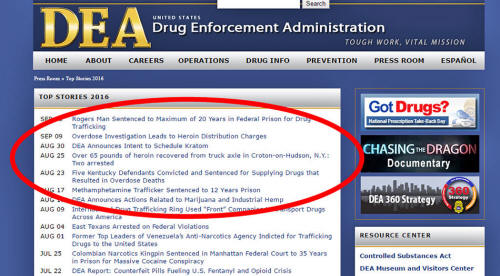|
September 20, 2016
Then, the DEA announced it would schedule kratom's active ingredients in the same Schedule I category, even though the increasingly popular Asian herb, like cannabis, could potentially help curb the nation's current opiate addiction epidemic.
To some Americans, these two actions demonstrate just how hopelessly out of touch the DEA is.
But the agency's ineptitude isn't limited to misguided and stubborn decisions to ban plants. It's actually out in the open for all to see on the DEA's own website.
The DEA's "Top Stories of 2016" page, which contains a selection of press releases the agency has issued throughout the year, is intended to highlight the valiant efforts of DEA agents in the fight against drugs.
But a simple analysis of the headlines reveals just how little the DEA has done to achieve its goals.
Here's a sampling of their top stories:
At first glance, it appears the DEA is doing a bang-up job.
Look at all the bad guys they've caught...!
Can you believe they seized half a million dollars worth of scary drugs in one mission? Bless the men and women in uniform who fight to keep our children 'safe'...!
At second glance, however, one might begin to wonder why, nearly fifty years after the Drug War's inception in 1971, the DEA is still struggling to contain the flow of illegal drugs in the United States.
Search for yourself. Perform a simple Google query on drugs seized by the DEA and law enforcement agencies around the country.
You'll find that seemingly every day, shipments of cannabis, cocaine, methamphetamines, heroin, and other drugs are seized by government agencies. Traffickers are charged with crimes and, to be fair, significant quantities of drugs are removed from the streets.
But even the DEA admits that, in general, increased seizures mean more drugs are in circulation.
In the agency's 2016 National Heroin Use Threat Assessment Summary, they note the recent uptick in drug seizures,
The agency's efforts to reduce the circulation of drugs and the power of traffickers are further discredited amid evidence that legalizing cannabis has decreased the power of Mexican drug cartels.
In contrast, 80% of drugs from Colombia,
One can suspect that if cocaine were legalized, the black market demand for it - and therefore, the power of cartels - would be reduced.
After 45 years and countless pounds of illicit substances seized, the war on drugs is yet to be "won," even as the DEA increasingly requests more money for its budget.
Take it from the government's own National Institute on Drug Abuse:
Do you mean to tell me that in spite of law enforcement's grand efforts to intercept literal tons of cannabis, use of the drug is still on the rise?
That's as preposterous as claiming alcohol prohibition in the 1920s failed to stop people from drinking!
Oh, wait. Even the DEA itself has acknowledged the rise in drug use.
From its 2016 National Heroin Use Threat Assessment Summary:
The report further highlights the severity of the problem, which has been exacerbated by the government's own double standard when it comes to banning some dangerous drugs while classifying others as medicine:
That's right. Nearly five decades, $1 trillion dollars, and thousands of destroyed lives later, the war on drugs has failed to stop drug use...
In 1971, President Richard Nixon - who, according to a former adviser, launched the modern drug war in part to crack down on anti-war and black rights movements - warned that,
As he urged Congress:
Richard Nixon's words are still embarrassingly true.
The United States still has more opiate addicts than any other nation - they gobble up 80% of the world's supply. Though pharmaceutical opiates constitute much of this figure, this growing habit, as the DEA acknowledged, drives users to heroin.
Nixon's words are also still timely considering government's attempts to stop drug use and addiction remain "not sufficient." In fact, earlier this year, two U.S. senators called the heroin and prescription opioid epidemic "a national emergency" - the exact term Nixon used to push the war in the first place.
If, after almost fifty years, the conditions that officially inspired the drug war haven't changed, perhaps it's time for a change in strategy, not a continuation of it - especially when it was waged for reasons wholly unrelated to keeping people safe.
As Nixon's former advisor, John Ehrlichman, said toward the end of his life when he admitted the Drug War was conceived to stifle dissent:
|


